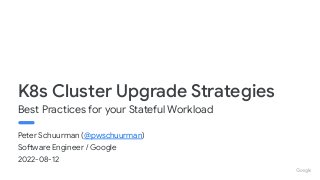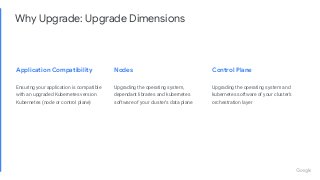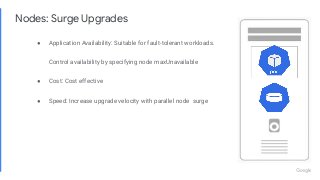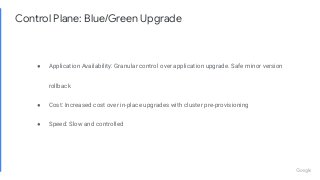Kubernetes Cluster Upgrade Strategies and Data: Best Practices for your Stateful Workload
- 1. Peter Schuurman (@pwschuurman) Software Engineer / Google 2022-08-12 K8s Cluster Upgrade Strategies Best Practices for your Stateful Workload
- 2. Agenda ŌŚÅ Why Upgrade? ŌŚÅ Stateful Workloads and Upgrades ŌŚÅ Nodepool Upgrade Strategies ŌŚÅ Control Plane Upgrade Strategies ŌŚÅ Upgrade Strategy and Workload Selection
- 3. Why Upgrade: Kubernetes Version Lifecycle source
- 4. Version Skew Kubernetes Version Skew Policy maintains support for 2 node minor versions New Features New features are introduced in upcoming Kubernetes versions. Eg: StatefulSet MaxUnavailable was introduced in 1.24. Security Compliance Organizations following compliance protocols (PCI, HIPAA, FedRamp) are required to apply security patches within 30 days of availability Patch Support Kubernetes minor versions are maintained for 1 year Why Upgrade: Modern and Protected
- 5. MariaDB has modernized their architecture by bringing SkySQL to the cloud on Kubernetes. Built using the Kubernetes operator pattern, MariaDB leverages resiliency and maintains high availability during upgrades. We have been using containers for many years ŌĆ” Our goal was to simplify the implementation and focus less on lower-level infrastructure, dependencies and instance life-cycle. With Kubernetes, our engineers could leverage the strong momentum from the open source community to drive infrastructure logic and security. (Reference) Why Upgrade: Modern Applications
- 6. Why Upgrade: Upgrade Dimensions Application Developer Kubernetes Administrator Cloud Platform
- 7. Why Upgrade: Upgrade Dimensions Application Developer Kubernetes Administrator Cloud Platform
- 8. Why Upgrade: Upgrade Dimensions Application Compatibility Nodes Control Plane Ensuring your application is compatible with an upgraded Kubernetes version Kubernetes (node or control plane) Upgrading the operating system, dependant libraries and kubernetes software of your clusterŌĆÖs data plane Upgrading the operating system and kubernetes software of your clusterŌĆÖs orchestration layer
- 9. Why Upgrade: Key Concerns Application Availability Cost Speed
- 10. Nodes: Surge Upgrades ŌŚÅ Application Availability: Suitable for fault-tolerant workloads. Control availability by specifying node maxUnavailable ŌŚÅ Cost: Cost effective ŌŚÅ Speed: Increase upgrade velocity with parallel node surge
- 11. Nodes: Blue/Green Upgrades ŌŚÅ Application Availability: Granular control during migration ŌŚÅ Cost: Increased cost with resource pre-provisioning ŌŚÅ Speed: Slow and controlled
- 12. Node Upgrade Takeaways Surge Upgrades Blue/Green Upgrades Application Availability Rollback scenarios make take more time High degree of application availability Cost Lower cost, upgraded node creation occurs just in time Higher cost, upgraded nodes are pre-provisioned Speed Nodes can be upgraded in batches for increased speed Higher control over node migration reduces speed
- 13. Control Plane: Upgrades ŌŚÅ Kubernetes maintains API versions with each minor release ŌŚÅ API schema may change with new minor versions
- 14. Control Plane: Surge Upgrade ŌŚÅ Application Availability: HA control plane setups limit disruptions. Kubernetes minor rollback is not supported ŌŚÅ Cost: Cost effective ŌŚÅ Speed: Fast
- 15. Control Plane: Blue/Green Upgrade ŌŚÅ Application Availability: Granular control over application upgrade. Safe minor version rollback ŌŚÅ Cost: Increased cost over in-place upgrades with cluster pre-provisioning ŌŚÅ Speed: Slow and controlled
- 16. Control Plane: Blue/Green Upgrade ŌŚÅ KEP-3335: Introduces building blocks to the StatefulSet API to enable StatefulSet replicas to be moved across clusters. ŌŚÅ With Kubernetes Multi-Cluster Services (KEP-1645), applications can maintain connectivity ŌŚÅ Demo
- 17. Control Plane Upgrade Takeaways Surge Upgrades Blue/Green Upgrades Application Availability Rollback is not possible Applications can be rolled back to a cluster with a known compatible Control Plane Cost Lower cost, upgraded control plane creation occurs just in time Higher cost, cluster pre-provisioned Speed Control Plane upgrade is fast and scales sub-linearly as cluster size increases Upgrade speed scales with application migration speed
- 18. Takeaways ŌŚÅ Trade-off between business requirements: application availability, speed and cost ŌŚÅ Modern applications update consistently and often ŌŚÅ Kubernetes has the tools to support safe stateful upgrades today, and the community is building new tools to increase this margin of safety


















